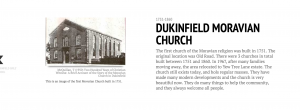I believe that chronology of events is extremely important because it allows us to see cause and effect. We would not be able to know and understand the outcome of any given event if we were not given the timing. There would be know way to learn from past mistakes or make changes in the future if we were not given the chronology of events. As mentioned in Grafton’s introduction, timelines allow us to compare “individual histories to one another and the uniform progress of the years” in a manner where we can see the connections and development (Grafton 15). Chronology allows us to see patterns and identify relationships between different events which is vital in both learning and decision making. We can represent history both with chronology and geography which is what is encompassed in the timeline that Paige and I created. Even though “historical problems posed by graphic representations of time have largely been ignored” in the past and it may seem simple at first, a timeline can tell us an abundant amount about the past because it utilizes both chronology and geography which are essential in representing history (Grafton 10).

In order to create a timeline of Harriet Lees’ life, Paige and I extracted key dates out of her memoir and placed them onto the timeline. We then had to do research to get a better context as to what was going on in Leominster, where she lived, and the surrounding areas during the time she was alive. By looking at where she lived and important events happening there during the early nineteenth century, we were utilizing the geographic mode of representation. We then found that the Industrial Revolution, Bath Houses, and the tuberculosis outbreak were big events going on during the time period in which Harriet Lees was alive. After putting those events into the timeline, we immediately saw the correlation because we were able to use the chronological mode of representation. We saw how the events going on in Great Britain at the time intertwined with the struggles that Harriet Lees faced throughout her life. We would never have been able to draw these connections and conclusions without plotting this information on a timeline.

 For example, we knew that Harriet Lees suffered from lung inflammation and was constantly ill, but we did not realize that her illness was a part of the larger tuberculosis outbreak that was going on in Great Britain.
For example, we knew that Harriet Lees suffered from lung inflammation and was constantly ill, but we did not realize that her illness was a part of the larger tuberculosis outbreak that was going on in Great Britain.
I am now able to have a better understanding of the complex relationship between ideas and modes of representation because I was able to visually see the cause and effect of events by each event’s location on the timeline and I could visually understand what the context of each event was from the pictures with the assistance of a short description. Putting this timeline together made me realize that a line, not just chronology can tell a story. The pictures and descriptions made what was just chronology come to life. The timeline we made models after chronographics which Grafton discussed in his introduction. However, I feel the layout of our timeline addresses the problem that chronographics had in the seventeenth century, “how to simplify, how to create a visual scheme to clearly communicate the uniformity, directionality, and irreversibility of historical time” (Grafton 19). Our timeline includes the visualizations; however, it does not lose site of the sequence of events.
[iframe src=’https://cdn.knightlab.com/libs/timeline3/latest/embed/index.html?source=13LSz87T6SWQHJEAbTZE6ZBNhhtDZGD5hMGe6mzC-SSY&font=Default&lang=en&initial_zoom=2&height=650′ width=’100%’ height=’650′ webkitallowfullscreen mozallowfullscreen allowfullscreen frameborder=’0′></iframe]
Hailey Zimmerman is a sophomore finance major at Bucknell University in Lewisburg, PA. She is from Darien, CT.



